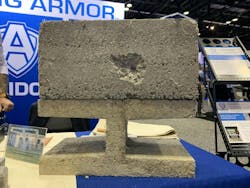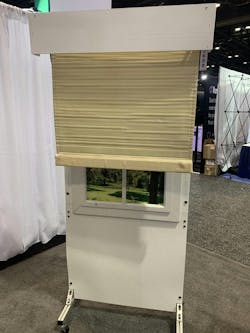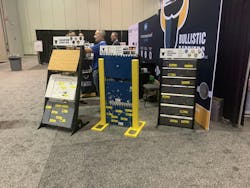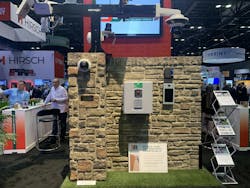This year’s GSX conference in Orlando, Florida, saw a wealth of companies showcase their perimeter security barriers alongside their mission statements.
With people at home fearful of stewing tensions overseas and heightened reporting on workplace and school violence, the businesses on show hope to placate their fears with robust perimeter security solutions built to stop bullets in their tracks.
360 Ballistics LLC
One such company is 360 Ballistics, which got its start working with the military, designing ballistic training facilities for the U.S. Army and the U.S. Marine Corps. After re-engineering their products to broaden their horizons to civilian audiences, the company arrived on the GSX show floor with myriad anti-ballistic products to defend against bullets, blasts, and even electromagnetic attacks.
Amidon ArmorBlock and Amidon Shield were the company’s center stage products this year. ArmorBlock consists of concrete masonry units (CMUs) filled with the company’s Shield material, a High Performance Shock Absorbing Material (HPSAM).
The fill, which exceeds 4,500 psi compressive strength and surpasses UL 752 level 10 standards, pairs with ArmorBlock to create a bulletproof environment.
According to 360 Ballistics Managing Partner Mark Buchmann, the product’s major selling point is its easy installation and flexibility. “Our product can be installed by any traditional, well-trained mason,” Buchmann says. “The open-ended blocks don’t leave any seams, and organizations can switch from traditional cinder blocks to ArmorBlock as needed.”
Also on display was Amidon eShield, an electromagnetic fabric meant to couple with ballistic materials to defend against electromagnetic attacks and energy weapons. The material, which is similar to Kevlar, doesn’t break down when exposed to water or ultraviolet rays.
On the cybersecurity side, the product was designed to prevent targeted Wi-Fi attacks and data signal interception.
The driving motivators for the introduction of these products, Buchmann explains, are rising international tensions and civil unrest. “We’ve been contacted by a lot of individuals who want to put ballistic protection in safe rooms, but also in their homes and offices. We have the capabilities, so we want to protect people.”
To that end, the company’s showing at GSX this year is meant to draw the attention of construction groups and engineers who are developing saferooms and safer living spaces alike. “Our product isn’t as well known in the market as we’d like it to be,” Buchmann says. “We’re looking for the opportunity to expand our business into the civilian sector.”
Ballistic Barrier Products
Ballistic Barrier Products arrived on scene with a similar story. A developer of bullet-resistant door shields, curtains, panels, and barriers, the company has seen rising levels of interest following international unrest and the fear of gun violence that comes with it.
“People are fearful,” says David Hildner, Sales and Business Development at Ballistic Barrier Products. “Geopolitical tensions and divisions alongside conflicts overseas have been driving a lot of demand for bullet-resistant products.”
Most of this demand comes from religious and government organizations, as well as residents in higher-end neighborhoods, though there has been a sharp uptick in schools seeking the company’s custom-made shields to defend their students. The window shades and door treatments are made-to-order and meant to fit into existing structures without modifying them, a design philosophy that allows for environmental camouflage that allows students, workers, and residents to continue business as usual without feeling “on edge.”
“They are much less invasive and can be colored and decorated as needed, allowing them to easily meld into the environment,” Hildner adds. “Our market focus is on existing structures where glass is prohibitive; you don’t want to have to tear apart the building to hold its weight. By allowing custom fits, we can fit into all of the idiosyncrasies of space, heat, ducts, or ventilation in different areas.”
The company’s bullet-resistant, roll-up door shields and window shades on display at the event showed this design philosophy first-hand, with a lightweight appearance and multiple colors available to customize with when placing an order. Similar to window shades, the Kevlar rolls easily retract as necessary, locking into mounts that sit at the end of the protection zone. This function is controlled by the user via wall switch and wireless remote control or can be connected to an existing alarm system.
The product defends against common handgun variants, including 9mm, .357, .45, 10mm, and 44. Magnum, and is UL 752 Level 3 and 2 certified.
Avient Corporation
Avient Corporation came to the show looking to attract business in critical infrastructure verticals. “There are a lot of substations in the past few years that have been shot up, and it has been affecting the power grid all over the world,” says Avient Eastern Regional Sales Manager Scott Powers. “We want to make sure the bad guys can’t walk up off the street and get a line of sight on this infrastructure through the chain link fence.”
The ThermoBallistic and GlasArmor ballistic and blast-resistant composite panels on display at the show are designed for exactly this. While electrical substations are the company’s most in-demand market, schools, government buildings, military structures, and other critical assets also fall under Avient’s umbrella.
Thermally formed with e-glass and thermoplastic resin, Avient’s bullet-resistant variants offer lightweight alternatives to fibers like Kevlar while meeting the UL 752 Level 3 ballistic rating. Powers emphasizes the anti-ricochet capabilities of the product; its composite matrix retains projectiles to prevent additional injury.
Bullistic Barriers
On show at the Bullistic Barriers booth this year are its series of bullet-resistant fences and barricades. Designed for aesthetics and ease of deployment, Bullistic’s barriers come with artistic accents and are shipped pre-assembled. They also come with integrated crash resistance and are engineered to withstand bullets and wind load while negating the additional hazard of bullet ricochet. The adaptability of the product is the point, as the company’s primary goal at GSX is to expand into multiple verticals.
Formerly a commercial and residential fencing company, Bullistic Barriers arrived in Orlando this year to get their foot in the door with governmental agencies. With five years under its belt in this arena, the company is fairly young but looking to expand wherever their expertise is needed.
“We go where there’s demand,” says Amos Glick, Manager of Bullistic Barriers. “Government facilities are what we’re aiming for, but we work projects from overseas embassies to people in residential areas with car collections to protect. We want to show the market that ballistic fences don’t need to look horrible, and that rapidly deployable fences can be lightweight and still take a punch.”
This demand has surged alongside the turbulent geopolitical landscape. Of particular interest to Glick are schools, which have begun funding efforts to reinforce their playgrounds against stray bullets and other unwelcome fire. “There are kids at risk and not enough funds to put strong security in place,” Glick says.
To remedy this, Glick emphasizes the company’s efforts to help school administrators and security teams find the most financially viable solutions. Perimeter fencing is expensive on its own, and few schools understand the magnitude of funding required to invest in full-protection ballistic barriers. “We want to protect our kids and provide a safe harbor for them, but the grant process feels as complicated as it can be,” he says. “Our job is to help administrators through that process, but it’s a difficult road ahead.”
In the future, Bullistic Barriers hopes to provide further services to schools, including the potential development of in-school anti-ballistic wall devices that deploy during active shooting situations. “We’d love to put more R&D into solutions like that in the future,” he comments. “School security should be at the forefront of every conversation.”
3B Protection
3B Protection, a Florida-based ballistic company servicing the government and utility industries, linked arms with Convergint at this year’s show to unveil patent-pending security column technology designed to safeguard critical infrastructure. Brent Warzocha, Convergint’s Business Development Manager, explains that the technology can also be utilized in the bulk energy space and critical substations, among other applications.
“The way perimeter security is accomplished is by trenching,” he elaborates. “Concrete pads, poles, it’s all very costly critical infrastructure. We have a new solution that allows teams to bypass all of that.”
The wall itself is used as a support for other security elements, eliminating the need for trenching and other installations. 3B’s partnership with Convergint also allows for the integration of Convergint’s equipment directly into the wall system. It also carries a K12 crash rating and can withstand vehicle impacts up to 50 miles per hour.
3B’s technology offers the obvious physical safety benefits of a ballistic barrier, but Warzocha also emphasizes the visual barrier aspect. Most critical infrastructure is surrounded by chain-link fencing, which offers a clear line of sight for threat actors. A solid physical wall with anti-climbing properties prevents threat actors from looking inside the perimeter to target and fire at things like transformers while also blocking access.
The primary driver of this technology, and of 3B’s presence at the show, are the increasing demands levied by the bulk energy market. With high levels of geopolitical tension come heightened fears of physical attacks on critical infrastructure and even overseas embassies. Defending critical substations is another major point of interest.
“Ballistic barriers are top of mind for them,” Warzocha says. “Nearly every organization is seeking anti-ballistic technology, so we are seeing a lot of traction in that sector.”








